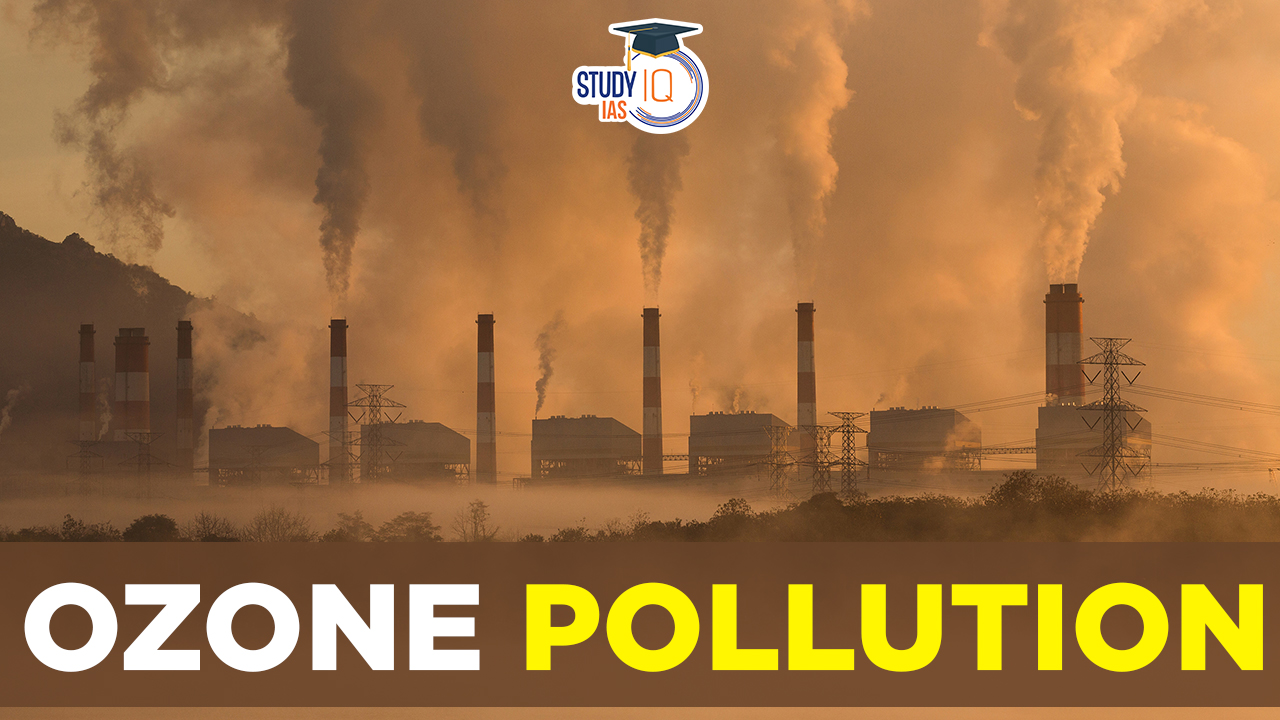Table of Contents
Context: According to Central Pollution Control Board (CPCB), Ground-level ozone (O3) has been identified as a prominent pollutant in Delhi.
What is Ozone (O3) Pollution?
- Ozone (O3) is a highly reactive gas composed of three oxygen atoms. It is both a natural and a man-made product.
- It occurs in the Earth’s upper atmosphere (the stratosphere) and lower atmosphere (the troposphere).
- Depending on where it is in the atmosphere, ozone affects life on Earth in either good or bad ways.
- Good Ozone: In stratospheric ozone, good ozone occurs naturally in the upper atmosphere, where it forms a protective layer that shields us from the sun’s harmful ultraviolet rays.
- Bad Ozone: Tropospheric or ground level ozone, is not emitted directly into the air, but is created by chemical reactions between oxides of nitrogen (NOx) and volatile organic compounds (VOC).
- This happens when pollutants emitted by cars, power plants, industrial boilers, refineries, chemical plants, and other sources chemically react in the presence of sunlight. This leads to ozone pollution.
Impacts of Ozone Pollution
- Health: Ozone causes exacerbation of asthma and chronic respiratory diseases such as chronic bronchitis (also called chronic obstructive pulmonary disease or COPD).
- Impact on biodiversity: Elevated exposures to ozone can affect sensitive vegetation and ecosystems, including forests, parks, wildlife refuges and wilderness areas.
- Low crop output: Elevated levels of ozone leads to reduced agricultural crop and commercial forest yields, reduced growth and survivability of tree seedlings, and increased susceptibility to diseases, pests and other stresses such as harsh weather.
- Destruction of species: High levels of ozone also disturb the stability of ecosystems, leading to sensitive species dying out.

Ozone Layer Protection: Global Efforts
- Montreal Protocol: Montreal Protocol is an international treaty, adopted in Montreal on September 16, 1987, that aims to regulate the production and use of chemicals that contribute to the depletion of Earth’s ozone layer. India became a Party to the Montreal Protocol in 1992.
- Kigali Amendment: The Kigali Amendment to Montreal Protocol aims for the phase-down of hydrofluorocarbons (HFCs) by cutting their production and consumption. The goal is to achieve over 80% reduction in HFC consumption by 2047. India has adopted this Amendment.
- An important feature of this amendment is the principle of Common but Differentiated Responsibilities and Respective Capabilities which recognizes the development imperatives of high-growth economies like India, and provides a realistic roadmap for the implementation of a phase-out schedule for high global warming potential (GWP) HFCs.
Central Pollution Control Board
- It is a statutory organization constituted in September, 1974.
- It serves as a field formation and also provides technical services to the Ministry of Environment and Forests of the provisions of the Environment (Protection) Act, 1986.
- It promotes cleanliness of streams and wells in different areas of the States by prevention, control and abatement of water pollution, and it also improves the quality of air and to prevent, control or abate air pollution in the country.
Government of India Initiatives to Tackle Ozone Pollution
- Shifting to BS-VI compliant vehicles from BS-IV as BS VI-compliant fuel is more refined than existing fuel which shall help curb emission of major pollutants like sulphur and nitrogen oxide.
- National Clean Air Programme (NCAP) aims to improve air quality in 131 cities of India with reductions up to 40% in National Ambient Air Quality Standards for Particulate Matter10 (PM 10) concentrations by 2025-26.
- Sustainable Alternative Towards Affordable Transportation (SATAT) aims to set up 5,000 Compressed Bio-Gas (CBG) production plants in India by 2024.
- National Mission for Green India aims to increase forest/ tree cover on forest/ non-forest lands and improve quality of forest cover.
- Control of Pollution Scheme is a central sector scheme that aims to curb environmental pollution in India by monitoring air quality across the country and take appropriate air pollution mitigation measures.
- Faster Adoption and Manufacturing of Electric Vehicles (FAME) scheme has been launched under the National Electric Mobility Mission, to encourage electric and hybrid vehicle purchase by providing financial support.
- Extended Producer Responsibility (EPR) framework for plastic packaging, battery waste, tyre waste and e-waste have been implemented.
- Network of metro rails for public transport are enhanced and more cities are covered.
- Development of Expressway and Highways are also reducing the fuel consumption and pollution.
- Introduction of cleaner/alternate fuels like CNG, LPG, ethanol blending in petrol.
- Ban on use of pet coke and furnace oil in NCR, use of pet coke in processes in cement plants, lime kilns and calcium carbide manufacturing units.
- Stringent emission norms for Coal based Thermal Power Plants (TPPs).
Way Forward
- The government needs to take active steps to mitigate primary pollutants, which lead to ground ozone formation.
- These steps involved curbing private vehicle usage, increasing electric mobility, scaling up public transport and pedestrian infrastructure, deploying citywide parking management, and aggressively controlling industrial emissions.


 Daily Quiz 05 July 2025
Daily Quiz 05 July 2025
 SSC MTS Apply Online for 1075 Posts – ...
SSC MTS Apply Online for 1075 Posts – ...
 Dynamic Pricing: What It Is and Why It's...
Dynamic Pricing: What It Is and Why It's...





















